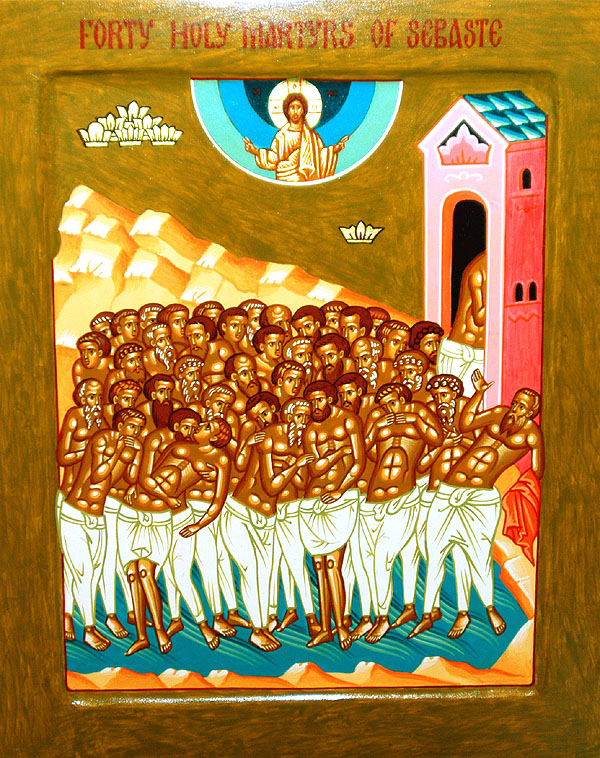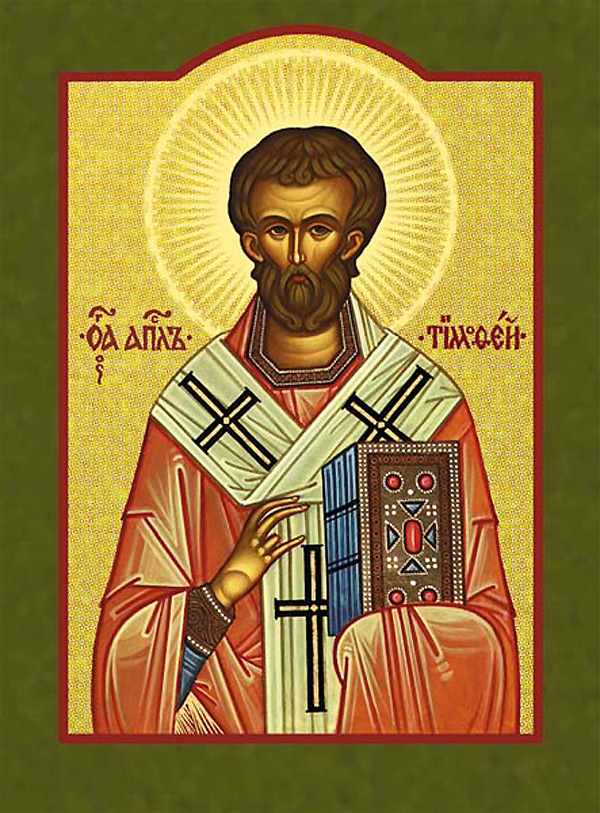40 Holy Martyrs of Sebaste
 In the year
In the year
One of the military commanders of that time in the Armenian city of Sebaste was Agricola, a zealous champion of idolatry. Under his command was a company of forty Cappadocians, brave soldiers who had distinguished themselves in many battles. When these Christian soldiers refused to offer sacrifice to the pagan gods, Agricola locked them up in prison. The soldiers occupied themselves with prayer and psalmody, and during the night they heard a voice saying, “Persevere until the end, then you shall be saved.”
Apostle Timothy of the Seventy
 The Holy Apostle Timothy was from the Lycaonian city of Lystra in Asia Minor. Saint Timothy was converted to Christ in the year 52 by the holy Apostle Paul (June 29). When the Apostles Paul and Barnabas first visited the cities of Lycaonia, Saint Paul healed one crippled from birth. Many of the inhabitants of Lystra then believed in Christ, and among them was the future Saint Timothy, his mother Eunice and grandmother Loida (Lois) (Acts 14:6-12; 2 Tim. 1:5).
The Holy Apostle Timothy was from the Lycaonian city of Lystra in Asia Minor. Saint Timothy was converted to Christ in the year 52 by the holy Apostle Paul (June 29). When the Apostles Paul and Barnabas first visited the cities of Lycaonia, Saint Paul healed one crippled from birth. Many of the inhabitants of Lystra then believed in Christ, and among them was the future Saint Timothy, his mother Eunice and grandmother Loida (Lois) (Acts 14:6-12; 2 Tim. 1:5).
The seed of faith, planted in Saint Timothy’s soul by the Apostle Paul, brought forth abundant fruit. He became Saint Paul’s disciple, and later his constant companion and co-worker in the preaching of the Gospel. The Apostle Paul loved Saint Timothy and in his Epistles called him his beloved son, remembering his devotion and fidelity with gratitude.
Questions and Answers about the Great Lent
 Great Lent and Pascha are the brightest and most instructive times in the Orthodox Calendar. That season begins with Forgiveness Sunday (March 10), when we mutually ask and receive forgiveness of one another. It is a season filled with prayer, services, spiritual and physical struggles, a time that culminates in the celebration of Pascha, Christ’s Resurrection (which this year falls on April 28).
Great Lent and Pascha are the brightest and most instructive times in the Orthodox Calendar. That season begins with Forgiveness Sunday (March 10), when we mutually ask and receive forgiveness of one another. It is a season filled with prayer, services, spiritual and physical struggles, a time that culminates in the celebration of Pascha, Christ’s Resurrection (which this year falls on April 28).
Holy Martyr Theodor of Komogovo
Teodor Sladić (Теодор Сладић) was born in a village in Kukuruzari (today Croatia) into a humble Serb family named Sladić. As a young man he accompanied a monk from the Serbian Orthodox Komogovina monastery (which is near his birthplace in Kukuruzari) to Moštanica monastery near Kozarska Dubica. He undertook an austere life both at Komogovina and Moštanica. When the Ottomans burned Moštanica, they killed many monks, as well as a large number of local Serbs from the surrounding villages.
The Holy Martyr George of Kratovo
By origin, George was a Serb from the town of Kratovo. He was a silversmith by trade and, in his heart and soul, was a convinced and a devout Christian. George was eighteen years old when the Turks tried to convert him to Islam. George remained as firm as a diamond in his faith. The Turks tortured him with many cruel tortures and finally burned him at the stake. He suffered for the beautiful Faith of Christ on February 11, 1515 A.D. in Sofia, Bulgaria, during the reign of Sultan Selim and was glorified with unfading glory in the heavens.






